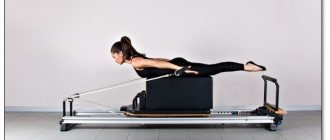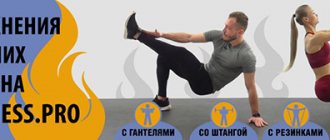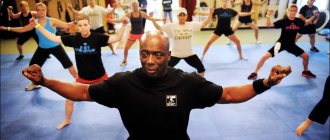Why are static exercises needed and what do they develop?
Static exercises are performed with constant tension for a certain period of time. Simply put, it is holding one position for a period of time, for example, from 30 seconds to 3 minutes.
Such exercises engage slow muscle fibers, while dynamic exercise engages fast, long fibers. Dynamics practically does not use slow fibers, which often become dormant. And in order to cross the plateau threshold, you must resort to involving new fibers and waking them up. This will increase muscle hypertrophy, their strength and even endurance.
Benefits of static fitness classes
The main advantages of isometric exercises include the following:
- it takes less time to perform static training movements than dynamic fitness training, so such exercises are an excellent solution for those people who are too busy and cannot devote 2 hours a day to visiting the gym;
- isometric physical activity is considered gentle and can be used even during the rehabilitation period after operations and injuries;
- regular static fitness classes help get rid of fat deposits and stimulate the growth of muscle cells;
- static exercises do not require additional material costs, and training movements of this nature can be performed at any time and almost anywhere.
The benefits and harms of static exercises
- Strengthens deep stabilizer muscles and improves overall appearance.
- Exercises strengthen muscles and ligaments.
- Improves the condition of the spine and internal organs.
- Static exercises are suitable for developing strength.
- Increase blood supply to muscles and organs.
- Static exercises can also be used for weight loss. A new load is a certain stress, and working with weakened fibers allows you to expend more energy and burn more calories.
Statics is not harmful to health , except for performing exercises with incorrect technique.
Also, some balance exercises can cause injury if you fall.
Types of isometric exercises
All exercises related to this type of contraction can be divided into three different categories. The first group includes pure isometric-static movements, when the muscles resist insurmountable resistance. The second category includes isometric exercises performed with weights, and during their execution pauses are maintained to obtain the necessary tension. The third group includes movements for which maximum weight is used.
A set of static exercises
Static exercises for all muscles of the body
Plank
The most common exercise that develops the main groups of external muscles and deep stabilizer muscles. The simplicity of the exercise and, at the same time, the difficulty of maintaining a level position develop both muscle strength and endurance. The plank improves your posture and is a great core workout.
It is necessary to place your palms strictly under the shoulder joints, and your feet shoulder-width apart, building a continuous, even line throughout the body. When doing the plank, it is important to constantly keep your abdominal muscles tense to prevent arching in your lower back. You need to maintain the position as long as the body can maintain the correct position.
Side plank
This type of plank is performed on one arm in a vertical plane. The main load is received by the arm muscles and oblique abdominal muscles. But the back, hips and buttocks work no less intensely when maintaining a stable position.
It is necessary to take a position in which the supporting arm will be positioned strictly vertically, and the torso will form a straight line together with the hips, without sagging at the hip joint. The exercise is performed on both sides for the same amount of time.
Reverse plank
This version of the plank also develops all the muscles of the body, especially the back and shoulder girdle. The abs and quadriceps work no less.
When performing the exercise with the stomach up, it is important that the hands are clearly under the shoulder joints, and the feet are hip-width apart, although in this version this is not important. It is important to keep your spine in a perfectly straight position and not sag your buttocks above the floor. Also, do not raise your pelvis too high, arching your lower back.
Reverse plank on one leg
The modification of the previous option is much more complicated and is suitable for those more advanced in training, especially in static loads. The starting position is performed in the same way, but the option of lifting one leg up is more complicated, in which the leg should be kept straight or bent at the knee. It should be understood that the load increases significantly, especially on the muscles that hold the spine in an even position. The pose is held with emphasis on each leg for the same period of time.
Read more about reverse planks →
Table
A lightweight version of the reverse plank, in which the legs are bent at the knees at a right angle. In this position, the stomach looks at the ceiling, the hands are under the shoulder joints, and the heels are strictly under the knees. The distance between the feet is equal to the width of the pelvis. In this case, the buttocks, lumbar extensors and abdominal muscles are heavily loaded. Make sure that the pelvis does not sag above the floor; to do this, strain the stabilizers - the stomach and buttocks.
One leg table
As in the reverse plank, the table is performed with support on one leg, and the position is not as stable, which generally makes it more difficult to load the muscles. It is necessary to keep the upper leg with the knee bent or straight, depending on the flexibility of the muscles of the back of the thighs. Perform the exercise on both sides for the same amount of time, maintaining precise technique.
Staff
Like all exercise options, the staff is used in yoga and resembles a lying position with narrow palms. Compared to the others, this is the most difficult technique for the shoulder girdle, which puts a lot of stress on the shoulders, triceps and forearms. The starting position for the staff is the plank. The technique is to bend your elbows at a right angle, keeping them as close to your body as possible. At the same time, the shoulders, chest and lower back should not collapse. Hold for as long as possible to maintain the position without changing technique.
Slide
Another popular yoga exercise that not only strengthens all the muscles of the body, but increases the flexibility of the muscles of the back of the body and stretches the spine. From the plank position, you need to push your pelvis up, lowering your chest as far as possible to the floor on straight arms. Knees should be straight. The tailbone tends upward. It is important to stretch the spine as much as possible, without swaying, but relaxing.
Static exercises for the buttocks
Shoulder bridge
The exercise develops and loads the gluteal muscles, additionally the hamstrings and lumbar extensors. Lying on your shoulder blades, you need to place your feet under your knees, with your heels closer to your buttocks. Lift your pelvis off the floor and lift it up, building a straight line with your body. It is necessary to hold the bridge using the force of the gluteal muscles, as well as the rectus abdominis muscle, to prevent possible hyperextension of the lower back. The chest should not protrude too much. The shoulder bridge can also be performed while standing on one leg.
Chair
The option loads the buttocks, lower back and thigh muscles. You need to place your feet hip-width apart and raise your arms up. Then tilt your torso at 45 degrees, bending your knees slightly, as if you were sitting on a chair. Hold the position as long as possible.
Stomach leg raise or locust
In this exercise, it is necessary to control the tension of the press, in which the lower back does not bend when lifting the legs above the floor. The amplitude is very small, but the tension in the gluteal muscles is quite intense.
Static exercises for the back and hips
Torso tilt
While standing, place your feet hip-width apart and raise your arms up. Tighten your abdominal muscles and tilt your torso with a straight spine forward until it is parallel to the floor. The knees remain straight. Constantly maintain tension in your abdominal muscles and do not round your back.
Martin
In addition to strengthening the back and hips, the swallow is excellent for developing balance. Standing with your arms above your head, lean forward with your torso straight, while simultaneously lifting your leg back, forming a solid line with your back and arms. Maintain your balance, then repeat on the other leg.
Balance on one leg
A simple hip strengthening exercise can be quite difficult if you have poor balance. Standing on one leg, lift your leg straight or bent at the knee in front of you so that your thigh is parallel to the floor. Hold your hands however you like - in front of you or above your head. Then change to the other side.
Tree
This seemingly simple exercise perfectly strengthens the adductor muscles of the thigh, which work the least in the previous versions. The essence of the exercise is not simply in maintaining balance, but in the pressure of the foot on the adductor surface of the thigh of the supporting leg, in which the muscles tense, resisting the pressing of the foot. Performed on both sides.
Boat on the stomach
As it is also called, static hyperextension, in which both the torso and legs are raised at the same time. The exercise strengthens the entire back of the body. It is important to keep not only your back and buttocks tense, but also your abdominal muscles, so that the deflection in the lumbar region is not so pronounced.
Cobra
Lying on your stomach, lift your chest off the floor and rest on your forearms. Place your elbows under your shoulder joints. Next, by tensing your back muscles, push your chest forward, collecting your shoulder blades as close to each other as possible. Maintain the position without raising your shoulders to your head, try to lengthen your neck.
Static abdominal exercises
Boat on the back
Lie on your back, place your arms along your torso. Collect your feet together. Lift your chest off the floor by twisting your upper torso while lifting your feet. The position is maintained by tensing the abdominal muscles, and under no circumstances should you hold your breath.
Lateral tilt
This option strengthens and stretches the oblique abdominal muscles. Standing with your feet hip-width apart, raise one arm above your head and bend in the direction opposite to your arm. Do not move your pelvis to the side. Hold the tilt for a certain amount of time, then change sides.
Corner
Sitting on your buttocks, straighten your back and move your torso back at an angle of 45 degrees, tensing your abs. Lift your feet off the floor and lift your shins. You can keep your knees straight - a difficult option - or bent. Keep your hands in front of you. Don't round your back.
What is isometric training?
During exercise, our muscles typically contract in three different ways (depending on the movement being performed). When lowering a weight (for example, when lowering a barbell while performing squats) or when “extending” with a load, an eccentric contraction of the muscles occurs. The opposite process: when lifting a weight, the muscles contract, reducing the distance between the joints - this is a concentric contraction.
But there is a third type of muscle contraction, when the muscles contract but do not change their length - isometric contraction. Unlike standard strength training, where the muscles perform sequential concentric and eccentric contractions, isometric loading is performed in a static position.
Examples of such exercises include pushing a stationary object, say a wall, or tensing a muscle without moving, such as a plank exercise, a wall squat, or holding the bottom position while performing an exercise, such as a squat. As a rule, isometric loading uses body weight (as you will see below), however, if your training allows, you can use additional weights.
Training Recommendations
- Whether you want to increase muscle strength or endurance, start doing exercises for 30 seconds to 1 minute. Then, as you get used to it, increase the hold time.
- It is important to perform all exercises with precise technique, and holding time is not as important as accuracy and feeling the load.
- To increase strength, try to gradually increase the time of exercise to three minutes. To do this, first tire the muscles with static exercises before dynamic ones. Or do it as a separate workout.
- To lose weight and maintain tone, you can alternate static exercises with dynamic ones. For example, do squats, then a plank for a minute, then lunges, and then a plank again.
Isometric exercise machines
There is a special simulator that promotes the use of isometric tension, developing the strength of individual muscle groups and increasing the strength of tendons and ligaments. A conventional simulator consists of a frame on which a support base is mounted. It can move and contains a fixed power unit. The bench is attached directly to the frame.
To perform various isometric strength exercises, the machine has a means for fixing a certain body position, and it is installed on a support frame. The power unit consists of two paired dynamometers with slip rings fixed on the rods. There is an information monitor and electric stopwatches. Having a diagram of the simulator, you can build it yourself for home training.
Isometric exercises - contraindications
Like any other type of training, static load has contraindications that are important to consider. To take into account possible negative consequences in the presence of chronic diseases, it is recommended to first consult with a doctor. Exercises in isometric mode cannot be performed if you have diseases of the musculoskeletal system, cesarean section or vision problems. You should avoid training if you have varicose veins, hemorrhoids and asthma.
Often, if you have such problems, you just need to limit the load or choose safe isometric exercises. It is important to consider that if the movements are performed incorrectly, you can get injured or provoke pressure surges. Experts recommend correctly calculating your strength, since excessive loads can be harmful.










